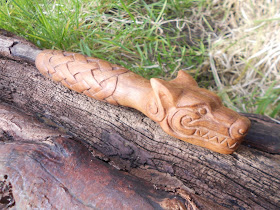
My name is Alistair Park and I'm a professional carver who is based in Bristol, England. I've been carving for over twenty-eight years and I also enjoy teaching my skills to people of all ages. You'll find posts here about all kinds of things to do with carving; the work that I do, the people that I meet and the things that I see which inspire me. Please feel free to comment on anything of interest, it'd be great to hear from you!
Thursday, 17 March 2016
A pagan ritual knife handle, carved in oak with a Viking-style wolf's head decoration
It was really enjoyable to do some carving with my Opinel knife recently, when commissioned to make a new handle for a pagan ritual blade. The oak came from a tree that originally grew near Nether Stowey, on the Quantock hills in Somerset.
The Norse-style wolf's head at the end was modelled on an example that the person who commissioned me already had on some jewellery, although I adapted it for the carving. I wanted it to have the look of an object that might have been carved by a Viking carver and to be very comfortable to hold, as well as beautiful.
The end of the handle is drilled to fit a 10mm (0.39") tang.
This image shows the handle against a tracing of the rest of the knife, so that you can get an idea of the scale:
I must admit that I liked the appearance of the carved handle before any finish had been applied. The patina of use would have looked good on it...
...but the finishing gave it a more 'antique' style. A woodworker in the neighbouring workshop said that it looks like it was finished at least ten years ago, rather than two days ago. For the finish, I used pure tung oil (extracted from a kind of nut) and then a mixture of natural waxes. Using natural finishes seemed more appropriate for this particular carving.
I really like the thought that this piece has another, deeper meaning to its new owner than the purely decorative. I hope that you have enjoyed seeing it too.







That's beautiful. What do you do if you make a mistake while carving, and accidently remove wood? Do you have to start again or are there tricks you can use?
ReplyDeleteBy the way, the planes that were cut down at the hospital, was that due to tree illness or some other reason? Hundreds are cut down here in France...
Well, mistakes certainly do happen (anyone who says otherwise is almost certainly fibbing!). Usually, I try to carve in such a way that it isn't too hard to sort out problems until the very final stages. Particularly when carving complex designs like knot work or portraits, deep cuts are left until much later so that the design can be moved around a bit if necessary.
ReplyDeleteWood being what it is, there's always a chance that an unseen weakness in it will cause problems and sometimes the only thing to do is very careful filling or gluing to sort it out. I think someone once said that the mark of a true professional isn't that they don't make mistakes, it's that they have the experience and skill to be very good at fixing them.
The plane trees were taken out as part of building work at the hospital. You'll be pleased to know that the
big one shown in the photo didn't get turned into wood chip though. I worked with a tree surgeon and wood miller named Julian Batt to plank it and those boards are now in careful storage. When they are seasoned in a couple of years time, I'm going to make something beautiful for the hospital from the timber. I'll keep you all posted!